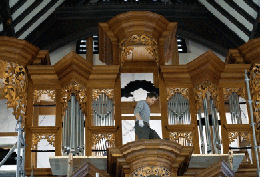Student suicides alter views of Cornell's iconic gorges; Cornell's Relief Efforts in Haiti Continue; Undergrads Win Goldwater, Truman Scholarships; Harris Departs for Post in Obama Administration; Mobile Apps for CU Library; Arecibo Founder Dies; Telescope's Future Blurry; How Now, Found Cow? Law School Explores Rules on Distracted Driving
Student suicides alter views of Cornell's iconic gorges

The University has been reeling in the wake of three student suicides over the span of several weeks, two of them on consecutive days. The suicides, in February and March, all took place in the gorges—drawing national media attention and prompting the Cornell community to take some drastic measures.
For several weeks this spring, guards were posted on the gorge bridges twenty-four hours a day. Myriad efforts have been made to reach out to those in need of counseling; volunteers plastered the spans with magnets advertising a crisis hotline, and the Daily Sun published full-page public service announcements promoting the campus's mental health resources. And most visibly, Cornell installed ten-foot-high, chain-link fencing on three of the four University-owned bridges as well as the three owned by the City of Ithaca. (The fourth Cornell-owned span, the pedestrian bridge over Beebe Dam, was already scheduled to be closed for the demolition of the long-defunct Hydraulics Lab.)
The fencing, which the administration says is temporary as it evaluates whether permanent barriers should be installed, has been highly controversial: some laud it as tangible proof of Cornell's commitment to deterring suicides while others have called it an eyesore that ruins the campus's iconic views. "As an architect," dean of students Kent Hubbell '67, BArch '69, said in a statement greeting Cornellians after spring break, "I look forward to the day when we have much more pleasing, permanent approaches for enhancing safety while preserving the natural and man-made beauty of our campus."
The University has created a website (caringcommunity. cornell.edu) as a clearinghouse for information about suicide prevention efforts and mental health services. In addition to offering tips on finding help and aiding others in distress, it has links to research on the role of barriers in deterring suicides. Such barriers are endorsed by the National Suicide Prevention Lifeline, which calls them "the most effective means of bridge suicide prevention" and cites numerous studies showing that barriers lower overall suicide rates rather than simply channeling potential jumpers to other methods.
Still, the barriers have drawn the ire of many students and local residents; they have prompted the creation of Facebook groups like "Don't Fence Us In" and "Cornellians Who Don't Want Bridge Fences" and even spawned a T-shirt parodying the popular "Ithaca is Gorges" slogan ("Ithaca is Fences"). "It definitely has a negative effect on the general emotional well-being of campus," Justin Richmond-Decker '12, creator of one of the Facebook groups, told the Sun in late March. "It feels like a prison, and that's not what this campus needs, especially now."
The three students who committed suicide in the gorges this spring were Bradley Ginsburg '13, William Sinclair '12, and Matthew Zika '11.
Cornell's Relief Efforts in Haiti Continue
While images of the Haiti disaster may have faded from the TV news, the nation is still in desperate straits as it struggles to recover from the January 12 earthquake. With a longstanding connection to Haiti via Weill Cornell's affiliation with the GHESKIO clinic in Port-au-Prince, the University has been working to support the rebuilding effort. In addition to raising funds—both by student groups and the Medical College's global health department—Cornell has been collaborating with other nonprofits to rebuild the damaged GHESKIO facilities and aid the more than 6,000 refugees camped on and near the grounds of the infectious disease clinic, co-founded more than three decades ago by Jean Pape, MD '75. "We've met with a number of different groups in trying to pull together a broad initiative," says Alice Pell, vice provost for international relations. "But the way the development community works, you can't just snap your fingers and start rebuilding a city." Pell notes that in addition to the problem of housing the thousands of homeless Haitians packed into refugee camps with poor sanitation—now made worse by the rainy season—there is another concern: the lack of economic opportunity. "People don't have jobs," she says. "That is a very serious part of it."

On campus, students have spearheaded a variety of fundraising efforts, from a banquet (jointly held by the Haitian and Caribbean student groups) to a series of bake sales, both real and "virtual." Landscape architecture students are working with an NGO to create Haiti's first urban park as a memorial to earthquake victims, and a group of graduate students in city and regional planning has formed a pro bono consulting firm to design affordable housing for the GHESKIO refugees. Pell, who saw the devastation first-hand during a weeklong visit to Port-au-Prince in February, notes that rebuilding the city's densely populated communities will be no easy feat. "The analogy one of the people at Weill has used," she says, "is changing a flat tire while the car is moving."
For more information, or to donate to the relief effort, go to weill.cornell.edu/globalhealth.
 Power suit: At the annual Cornell Design League Fashion Show in March, Hotel student Heather Donsky '10 modeled a "solar coat" created by fiber science and apparel design major Abbey Liebman '10 (inset). The garment, which has trim made of ultra-thin solar panels and a USB connection hidden in the waist, can charge handheld devices like cell phones and MP3 players.
Power suit: At the annual Cornell Design League Fashion Show in March, Hotel student Heather Donsky '10 modeled a "solar coat" created by fiber science and apparel design major Abbey Liebman '10 (inset). The garment, which has trim made of ultra-thin solar panels and a USB connection hidden in the waist, can charge handheld devices like cell phones and MP3 players.
Undergrads Win Goldwater, Truman Scholarships
Jessica Ye '12 and Sophia Porrino '11 have been awarded Barry M. Goldwater Scholarships, which cover tuition and other expenses up to $7,500 per year. They're among 278 Goldwater scholars in math, science and engineering, chosen for academic merit.
Ye is a biology and chemistry major in Arts and Sciences; she plans to pursue an MD and a PhD in immunology. Porrino, a College Scholar, has focused on neuroscience and psychobiology and plans to earn a PhD in neuroscience with a specialty in depression and anxiety. Biological science major Max Liu '11 earned honorable mention from the Goldwater program.
Government major and College Scholar Ali Hussain '11 also won a prestigious academic award this spring; he was one of sixty juniors nationwide awarded a Harry S. Truman Scholarship. Given in recognition of academic achievement, leadership, and commitment to public service, the award offers $30,000 toward graduate study.
Harris Departs for Post in Obama Administration
Deputy provost David Harris has taken an extended leave of absence to serve in the Obama Administration. Harris left Cornell in March to become deputy assistant secretary for human services policy in the Department of Health and Human Services, working on issues of poverty policy. A professor of sociology, Harris is coeditor of The Colors of Poverty: Why Racial and Ethnic Disparities Persist. He has held several high-level posts on campus, including interim provost.
Mobile Apps for CU Library
The University Library has gone mobile with a new website and application for smart phones. The site, library.cornell.edu/m, offers access to information like the catalog, hours, and events, in a streamlined version for tiny screens. The free iPhone app, designed last fall as a computer science class project, lets users check their accounts, renew books, and query librarians, among other features. Says library website co-director Nan Hyland: "One of our over-arching goals is to make the library accessible to people wherever they need us."

House organ: The new $2 million pipe organ in Anabel Taylor Chapel is nearing completion. The result of years of research, planning, and design— and two years of building—the organ is meant to recreate the sound of a German instrument built in 1706 and destroyed in World War II. Its more than 1,800 pipes must still be "voiced," with the first concert planned for November.
Arecibo Founder Dies; Telescope's Future Blurry
The astronomy community is mourning the passing of Bill Gordon, PhD '53, the former electrical engineering professor who designed the Arecibo radio telescope while on the Cornell faculty in the Fifties. Gordon, who moved to Rice University in 1966 but retired to Ithaca, passed away in February at the age of ninety-two.

The facility that Gordon conceived—the world's most powerful radio telescope, located in rural Puerto Rico and operated by Cornell through the National Astronomy and Ionosphere Center (NAIC)—faces an uncertain future. The NSF has made significant cuts to the observatory's budget, and Cornell's management of the telescope remains up in the air pending the completion of a much-delayed request for proposals (RFP) process.
But even as the telescope's funding has been cut, the scientific community has stressed its value; in January, for example, the National Research Council issued a report detailing its vital role in detecting near-Earth objects. "The telescope's doing amazingly good science," says NAIC director Don Campbell, PhD '71. "I don't quite understand the process here."
How Now, Found Cow?

Nearly four years after being calf-napped, a mascot has come home to the Cornell Dairy Bar. In August 2006, fiberglass cow Cornellia and her calf, Cal, vanished from their perch outside the Stocking Hall creamery. Cornellia appeared on the Hoy Field pitcher's mound a few months later; Cal has been MIA ever since. But in late March, a group of people wearing hoods was seen returning the calf, dropping it off at the Dairy Bar entrance in the middle of the night. Around its neck was a note claiming it had been found 350 miles away and that it was liberated "after a tense hostage negotiation." The note was signed "Narby Krimsnatch '59"—a fictional student created by campus pranksters in 1956. To discourage future bovine-related antics, the mascots have been moved inside the Dairy Bar, which offered a series of special sundaes (all with a base of Cornellia's Dark Secret, vanilla ice cream with chocolate flakes) to celebrate their reunion. More sundae specials to mark Cal's return are planned during Reunion weekend.
Law School Explores Rules on Distracted Driving
The Law School is teaming up with the federal Department of Transportation to keep the public informed as the agency formulates policy on distracted driving. Through the Cornell e-Rulemaking Initiative, the public can view and comment on proposed regulations. In late March, the DOT launched a monthlong comment period on the first rule, a ban on texting by interstate commercial truck and bus drivers. Transportation Secretary Ray LaHood calls the partnership "an important step toward keeping President Obama's promise of opening government to more effective citizen participation." For more information, go to ceri.law.cornell.edu.


